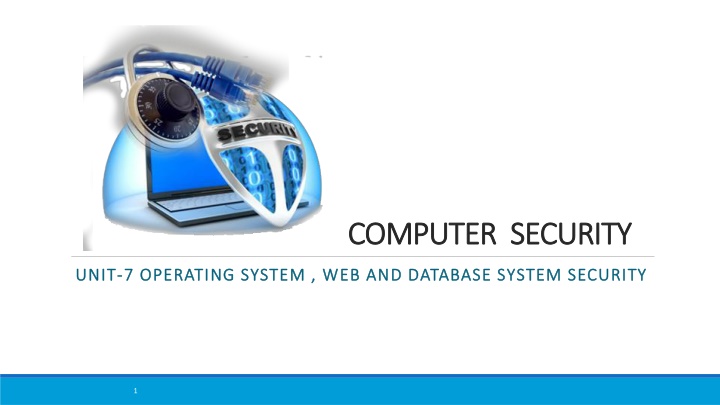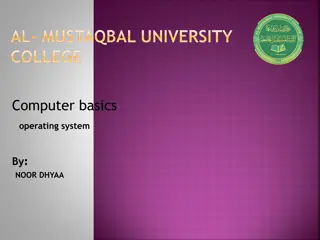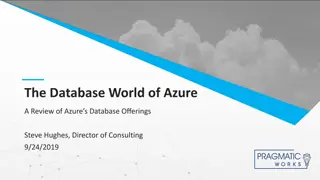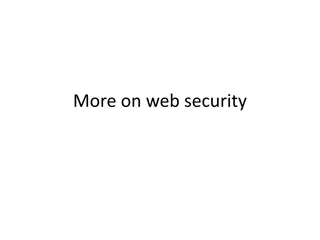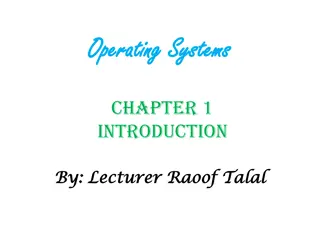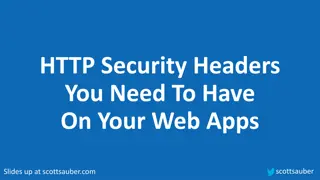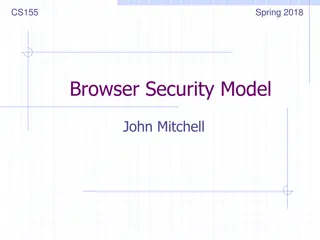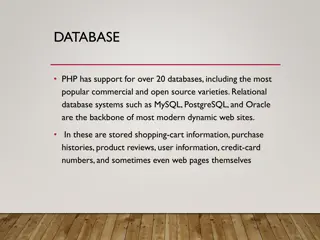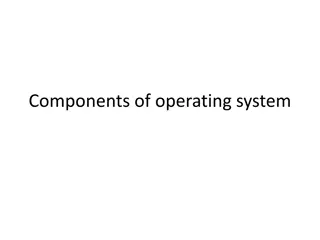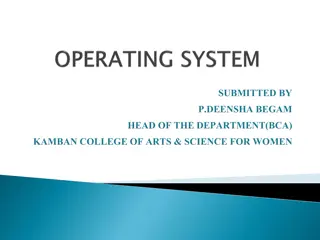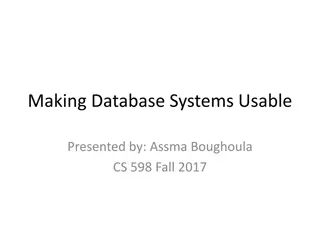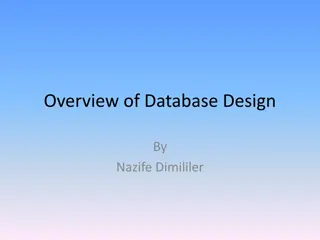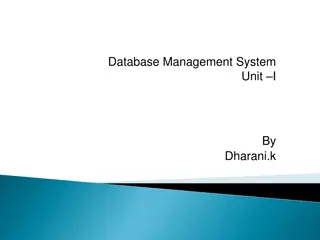Computer Security Unit Operating System Web Database
Operating systems, web, and database system security are crucial for protecting against access threats such as intruders and malicious software. Learn about different types of intruders and countermeasures like intrusion detection systems with this informative content.
Download Presentation

Please find below an Image/Link to download the presentation.
The content on the website is provided AS IS for your information and personal use only. It may not be sold, licensed, or shared on other websites without obtaining consent from the author.If you encounter any issues during the download, it is possible that the publisher has removed the file from their server.
You are allowed to download the files provided on this website for personal or commercial use, subject to the condition that they are used lawfully. All files are the property of their respective owners.
The content on the website is provided AS IS for your information and personal use only. It may not be sold, licensed, or shared on other websites without obtaining consent from the author.
E N D
Presentation Transcript
COMPUTER SECURITY COMPUTER SECURITY UNIT UNIT- -7 OPERATING SYSTEM , WEB AND DATABASE SYSTEM SECURITY 7 OPERATING SYSTEM , WEB AND DATABASE SYSTEM SECURITY 1
Operating System Security Operating System Security System System Access AccessThreats Threats System access threats fall into two general categories: Malicious software Intruders 2
Intruders Clandestine user Masquerader Misfeasor a legitimate user who accesses data, programs, or resources forwhich such access is not authorized, or who is authorized for such access but misuses his or her privileges an individual who seizes supervisory control of the system and uses this control to evade auditing and access controls or to suppress audit collection an individual who is not authorized to use the computer and who penetrates a system s access controls to exploit a legitimate user s account 3
Malicious Software Programs that exploit vulnerabilities in computingsystems Also referred to as malware Can be divided into two categories: parasitic fragments of programs that cannot exist independently of some actual application program, utility, or system program viruses, logic bombs, and backdoors are examples independent self-contained programs that can be scheduled and run by the operating system worms and bot programs are examples 4
Countermeasures RFC 4949 (Internet Security Glossary) defines intrusion detection as a security service that monitors and analyzes system events for the purpose of finding, and providing real-time or near real-time warning of, attempts to access system resources in an unauthorized manner Intrusion detection systems (IDSs) can be classified as: host-based IDS monitors the characteristics of a single host and the events occurring within that host for suspicious activity network-based IDS monitors network traffic for particular network segments or devices and analyzes network, transport, and application protocols to identify suspicious activity 5
IDS IDSComponents Components User interface Sensors Analyzers enables a user to view output from the system or controlthe behavior of the system receive input from one or moresensors or from other analyzer responsiblefor collectingdata the input for a sensor may be any part of a system that could contain evidence of an intrusion responsible for determining if an intrusion has occurred may equate to a manager, director,or console component types of input to a sensor include network packets, log files, and systemcall traces may provide guidance aboutwhat actions to take as a result of the intrusion 6
Authentication Authentication In most computer security contexts, user authentication is the fundamental building block and the primary line of defense RFC 4949 defines user authentication as the process of verifying an identity claimed by or for a system entity An authentication process consists of two steps: identification step presenting an identifier to the security system verification step presenting or generating authentication information that corroborates the binding between the entity and the identifier 7
M Means eans of of Authentication Authentication Something the individualknows examples include a password, a personal identification number (PIN), or answers to a prearranged set of questions Something the individualis (static biometrics) examples include recognition by fingerprint, retina, and face Something the individualdoes (dynamic biometrics) examples include recognition by voice pattern, handwriting characteristics, and typing rhythm Something theindividual possesses examples include electronic keycards, smart cards, and physical keys referred to as a token 8
Access AccessControl Control Implements a security policy that specifies who or what may have access to each specific system resource and the type of access that is permitted in each instance Mediates between a user and system resources, such as applications, operating systems, firewalls, routers, files, and databases A security administrator maintains an authorization database that specifies what type of access to which resources is allowed for this user the access control function consults this database to determine whether to grant access An auditing function monitors and keeps a record of user accesses to system resources 9
Fir Fire ew walls alls Can protecting a local system or network of systems from security threats access to the outside world via wide area networks and the Internet be an effective means of Design goals: network-based while affording 1) The firewall acts as a choke point, so that all incoming outgoing traffic the firewall traffic and all must pass through 2) The security policy, which defines traffic that is authorizedto pass firewall enforces the local the Traditionally, a firewall is a computer that interfaces outside a network and has special security precautions built into it in order to protect sensitive files on computers network dedicated with computers 3) The attacks firewall is secure against within the 10
Operating Systems Hardening Operating Systems Hardening Basic steps to use to secure an operatingsystem: Install and patch the operating system Harden and configure the operating system to adequately address the identified security needs of the system by: removing unnecessary services, applications, and protocols configuring users, groups and permissions configuring resource controls Install and configure additional security controls, such as antivirus, host-based firewalls, and intrusion detection systems (IDS), if needed Test the security of the basic operating system to ensure that the steps taken adequately address its securityneeds 11
Operating System Installation: Initial Setup and Patching System security begins with the installation of the operating System Ideally new systems should be constructed on a protected network The initial installation should comprise the minimum necessary for the desired system, with additional software packages included only if they are required for the function of the system The overall boot process must also be secured Care is also required with the selection and installation of any additional device driver code, since this executes with full kernel level privileges, but is often supplied by a third party 12
Remove Remove Unnecessary Unnecessary Services, Services, Applications Applications, ,and and Protocols Protocols The system planning process should identify what is actually required for a given system so that a suitable level of functionality is provided, while eliminating software that is not required to improvesecurity When performing the initial installation the supplied defaults should not be used, but rather the installation should be customized so that only the required packages are installed Many of the security-hardening guides provide lists of services, applications, and protocols that should not be installed if notrequired Strong preference is stated for not installing unwanted software, rather than installing and then later removing or disabling it as many uninstall scripts fail to completely remove all components of apackage should an attacker succeed in gaining some access to a system, disabled software could be re-enabled and used to further compromise a system it is better for security if unwanted software is not installed, and thus not available for use at all 13
Configure Configure Users, Groups, Users, Groups, and Authentication and Authentication The system planning process should consider: how and where they are defined and authenticated the types of information they can access thecategories of users on the system the privileges they have Restrict elevated privileges to only those users that require them At this stage any default accounts included as part of the system installation should besecured Those accounts which are not required should be either removed or at least disabled System accounts that manage services on the system should be set so they cannot be used for interactive logins Any passwords installed by default should be changed to new values with appropriate security Any policy that applies to authentication credentials and to password security is configured 14
Configure Configure Resource Resource Controls Controls Once the users and their associated groups are defined, appropriate permissions can be set on data and resources to match the specifiedpolicy This may be to limit which users can execute some programs or to limit which users can read or write data in certain directory trees Many of the security-hardening guides provide lists of recommended changes to the default access configuration to improve security 15
Install Install Additional Security Additional Security Controls Controls Further security improvement may be possible by installing and security tools such as antivirus software, host- based firewall, IDS or IPS application white- listing Given the wide-spread prevalence of malware, appropriate antivirus component configuring additional is a critical security software, or IDS and IPS software may include additional mechanisms such as traffic monitoring or file integrity checking to identify and even respond to some types of attack Some of these may be supplied as part of the operating systems configured and enabled by default installation, but not White-listing programs that can execute in the the system to just those inan explicit list applications limits the 16
Test Test the System the System Security Security The final step in the process of initially securing the base operating system is security testing The goal is to ensure that the previous security configuration steps are correctly implemented and to identify any possible vulnerabilities that must be corrected or managed Suitable checklists are included in many security-hardening guides There are also programs specifically designed to review a system to ensure that a system meets the basic security requirements and to scan for known vulnerabilities and poor configuration practices This should be done following the initial hardening of the system and then repeated periodically as part of the security maintenance process 17
Security SecurityMaintenance Maintenance The process of security maintenance includes the following steps: regularly testing system security performing regular backups using appropriate software maintenance processes to patch and update all critical software and to monitor and revise configuration as needed recovering from security compromises monitoring and analyzing logging information 18
Logging Logging Logging volumes of important that sufficient space is allocated for them can generate information so significant it Effective logging helps ensure that in the event of a system breach or failure, system administrators quickly and accurately happened and more their remediation and recovery efforts is can identify what effectively focus more A suitable automatic log rotation and archive system should be configured to assist in managing the overall size of the logging information Logging information can be generated by the system, applications network, and Some form of automated analysis preferred as it is more likely to identify abnormal activity manual analysis of logs is tedious and is not a reliable detecting adverse events is The range of logging data should be determined system planningstage acquired during the means of 19
Data Backup Data Backup and andArchive Archive Performing regular backups of data on a system is another critical control that assists with maintaining the integrity of the system and user data The needs and policy relating to backup and archive should be determined during the system planningstage key decisions include whether the copies should be kept online or offline and whether copies should be stored locally or transported to a remote site Backup the process of making copies of data at regular intervals, allowing the recovery of lost or corrupted data over relatively short time periods of a few hours to some weeks Archive the process of retaining copies of data over extended periods of time, being months or years, in order to meet legal and operational requirements to access past data 20
Access Access Control ControlScheme Scheme When a user logs on to a Windows system a name/password scheme is used to authenticate the user If the logon is accepted a process is created for the user and an access tokenis associated with that process object the access token includes a security ID (SID) which is the identifier by which this user is known to the the system for purposes of security the token also contains SIDs for the security groups to which the user belongs The access token serves two purposes: it keeps all necessary security information together to speed access validation it allows each process to modify its security characteristics in limited ways without affecting other processes running on behalf of the user 21
Web Security Web Security What is web security? Almost everything relies on computers and the Internet now communication (email, cell phones) transportation (car engine systems , airplane navigation ) medicine (equipment, medical records) shopping (online stores, credit cards) entertainment (digital cable, mp3s) Web Security, also known as Cybersecurity involves protecting that information by preventing, detecting, and responding to attacks. 22
What can Web users do? The first step in protecting yourself is to recognize the risks and become familiar with some of the terminology associated with them. 23
Web Security: Terminologies Hacker people who seek to exploit weaknesses in software and computer systems for their own gain. Viruses It you to actually do something before it infects your computer. This action could be opening an email attachment or going to a particular web page. Worms - Worms propagate without user intervention. Once the victim computer has been infected the worm will attempt to find and infect other computers. Trojan horses - A Trojan horse program is software that claims to be one thing while in fact doing something different behind the scenes. Ransomware : A form of trojan that has been around since 1989 (as the PCCYBORG trojan) It infects the target computer by encrypting the owner's personal files. The victim is then contacted and offered a key to decrypt the files in exchange for cash 24
KeyLoggers KeyLoggers: : Traditionally, Keyloggers are software that monitor user activity such as keys typed using keyboard. Modern keyloggers can, Record keystrokes on keyboard Record mouse movement and clicks Record menus that are invoked Take screenshots of the desktop at predefined intervals (like 1 screenshot every second) Such recorded data could be uploaded in real-time or when internet connection becomes available, by, Email attachment File Transfer (FTP) 25
Keylogger Prevention : Keylogger Prevention : Use Anti-Spyware (prevention) Firewall (manual detection) Automatic Form fillers (protection from keylogging) In public (insecure) places, -use on-screen keyboards (START-> ALL PROGRAMS ->ACCESSORIES -> ACCESSIBILTY -> ON-SCREEN KEYBOARD) Firewalls: Mechanism for content regulation and data filtering Blocking unwanted traffic from entering the subnetwork (inbound) Preventing subnet users' use of unauthorised material/sites (outbound) 26
Aspects of data Security Aspects of data Security Privacy : Keeping your information private , Your personal details are a valuable asset Businesses are increasingly looking to target individuals more effectively, data about those individuals is in demand Buying and selling lists of email addresses and demographic details is big business Integrity : Knowing that the information has not been changed , Maintaining the data integrity of any communication is vital. Integrity can be preserved by using strong encryption methods. Even if an intruder see the transmission, it would be useless since its encrypted. Authenticity : Knowing who sent the information , We need to authenticate a message to make sure it was sent by the correct person. Digital signature is used for the purpose Public key , Private key method can also be used to authenticate. 27
Web Security Issues Malicious websites SPAM 419 Scams Phishing DDOS Botnets (All aspects are inter-related) Phishing : This is a method of luring an unsuspecting user into giving out their username and password for a secure web resource, usually a bank or credit card account. Usually achieved by creating a website identical to the secure site User is sent email requesting them to log in, and providing a link to the bogus site When user logs in, password is stored and used to access the account by the attacker Difficult to guard against, particularly if using HTML email 28
Phishing Phishing Email sample: Subject: Verify your E-mail with Citibank This email was sent by the Citibank server to verify your E-mail address. You must complete this process by clicking on the link below and entering in the small window your Citibank ATM/Debit Card number and PIN that you use on ATM. This is done for your protection - because some of our members no longer have access to their email addresses and we must verify it. To verify your E-mail address and access your bank account, click on the link below: https://web.da-us.citibank.com/signin/citifi/scripts/email_verify.jsp Thank you for using Citibank The link uses an anchor text, and the actual website opens as, http://citibusinessonline.da.us.citibank.com.citionline.ru/... Instead of, http://www.citibank.com/us/index.htm 29
Take Action Take Action If everyone keep their systems secure, such threats can never happen. Small gestures can avoid gigantic problems in our context. Action Plan Use Anti-virus Use Anti-Spyware Be aware not to fall for scams and phishing attacks Report SPAM 30
Database System Security Database System Security Overview To Database Security. Why need of database security. What is Database Security Concepts of Database Security. Threats to Database and counter measures Methods of securing database. Through firewall Database Abstraction 31
Overview Overview Threats and risk to database have increased, So there is a need for security of the database. The majority companies store sensitive data in database. E.g.: Credit card number Data will be easily corrupted If there is no security to database what happens??? It is important to restrict access to the database from authorized users to protect sensitive data. 32
Security risk to database includes Security risk to database includes Unauthorized database users Bank/Demat accounts Credit card, Salary, Income tax data\ University admissions, marks/grades Land records, licenses Unauthorized Database Administrator Sensitive data includes Unauthorized access to Database Unauthorized alternation to available data Lack of access to Database services 33
Definition of Database Security Definition of Database Security Database Security is defined as the process by which Confidentiality, Integrity and Availability of the database can be protected 34
Database Security Concepts Database Security Concepts Enforced by encrypting the data in the stored database Encryption is a technique or a process by which the data is encoded in such a way that only that authorized users are able to read the data. Encryption is rendering sensitive data unreadable to unauthorized users. Confidentiality Enforced by defining which user has to be given permission to access the data in the database For Example: Data related to employee may have permission for viewing records and altering only the part of information like his contact details, where as the person like Human resource manager will have more privileges. Integrity Database must have not unplanned downtime. To ensure this ,following steps should be taken Restrict the amount of the storage space given to each user in the database. Limit the number of concurrent sessions made available to each database user. Back up the data at periodic intervals to ensure data recovery in case of application users. Availability 35
Threats to database Threats to database SQL Injection. Unauthorized access Password Cracking. Network Eavesdropping 36
SQL Injection SQL Injection A FORM OF ATTACK ON A DATABASE-DRIVEN WEB SITE IN WHICH THE ATTACKER EXECUTES UNAUTHORIZED SQL COMMANDS BY TAKING ADVANTAGE OF INSECURE CODE ON A SYSTEM CONNECTED TO THE INTERNET, BYPASSING THE FIREWALL Vulnerabilities: Countermeasures Poor Input validation to web application. Your application should constrain and sanitize input data before using it in SQL queries. Use type safe SQL parameters for data access. These can be used with stored procedures or dynamically constructed SQL command strings. Using SQL parameters ensures that input data is subject to type and length checks Unsafe ,dynamically constructed SQL commands. Use a SQL Server login that has restricted permissions in the database. Ideally, you should grant execute permissions only to selected stored procedures in the database and provide no direct table access. Weak permissions that fail to restrict the application to Database 37
Unauthorized Access Unauthorized Access DIRECT ACCESS TO YOUR DATABASE SERVER SHOULD BE RESTRICTED TO SPECIFIC CLIENT COMPUTERS TO PREVENT UNAUTHORIZED SERVER ACCESS. Vulnerabilities Countermeasures Failure to block the SQL Server port at the perimeter firewall Make sure that SQL Server ports are not visible from outside of the perimeter network. Within the perimeter, restrict direct access by unauthorized hosts, for example, by using IPSec or TCP/IP filters Lack of IPSec or TCP/IP filtering policies 38
Password cracking Password cracking A COMMON FIRST LINE OF ATTACK IS TO TRY TO CRACK THE PASSWORDS OF WELL KNOWN ACCOUNT NAMES, SUCH AS SA (THE SQL SERVER ADMINISTRATOR ACCOUNT). Vulnerabilities Countermeasures Create passwords for SQL Server login accounts that meet complexity requirements. Weak or blank passwords Avoid passwords that contain common words found in the dictionary. Passwords that contain everyday words 39
Network Eavesdropping Network Eavesdropping Eavesdropping refers to unauthorized access of reading messages The deployment architecture of most applications includes a physical separation of the data access code from the database server. As a result, sensitive data, such as application-specific data or database login credentials, must be protected from network eavesdroppers. Vulnerabilities Insecure communication channels Passing credentials in clear text to the database; for example: Using SQL authentication instead of Windows authentication Using SQL authentication without a server certificate 40
Diagrammatic Representation Diagrammatic Representation 41
Methods of securing the database Methods of securing the database Authorization - privileges, views. Authentication passwords. Encryption - public key / private key, secure sockets. Logical - firewalls, net proxies. 42
Security of the database through Security of the database through FIREWALLS FIREWALLS A FIREWALL is dedicated software on another computer which inspects network traffic passing through it and denies (or) permits passage based on set of rules. Basically it is a piece of software that monitors all traffic that goes from your system to another via the Internet or network and Vice Versa Database Firewalls are a type of Web Application Firewalls that monitor databases to identify and protect against database specific attacks that mostly seek to access sensitive information stored in the databases. 43
How Database FIREWALL works How Database FIREWALL works The Database Firewalls include a set of pre-defined, customizable security audit policies and they can identify database attacks based on threat patterns called signatures. The SQL input statements (or) queries are compared to these signatures, which are updated frequently by the vendors to identify known attacks on the database. But all the attacks on the databases may not be familiar. Database Firewalls build (or come with) white list of approved SQL commands(or) statements that are safe. All the input commands are compared with this white list and only those that are already present in the white list are sent to the database. 44
Diagrammatic Representation Diagrammatic Representation 45
Advantages of using FIREWALL Advantages of using FIREWALL Database Firewalls maintains the black list of certain specific and potentially harmful commands(or) SQL statements and do not allow these type of inputs. Database Firewalls identifies the database, operating system and protocol vulnerabilities in the databases and intimate the administrator, who can take steps to patch them. Database Firewalls monitors for database responses (from the DB server) to block potential data leakage. Database Firewalls notifies the suspicious activities, instead of blocking them right away. Database Firewalls can evaluate factors like IP address, time, location, type of applications (source), etc from which the abnormal database access requests are emanating and then decide whether to block them or not, based on these factors as per the policies set by the administrator. 46
Security of the database Through Security of the database Through Abstraction Abstraction Data encryption enables to encrypt sensitive data, such as credit card numbers, stored in table columns. Encrypted data is decrypted for a database user who has access to the data. Data encryption helps protect data stored on media in the event that the storage media or data file gets stolen. 47
How data Encryption Works How data Encryption Works Data encryption is a key-based access control system. Even if the encrypted data is retrieved, it cannot be understood until authorized decryption occurs, which is automatic for users authorized to access the table. When a table contains encrypted columns, a single key is used regardless of the number of encrypted columns. This key is called the column encryption key. The column encryption keys for all tables, containing encrypted columns, are encrypted with the database server master encryption key and stored in a dictionary table in the database. The master encryption key is stored in an external security module that is outside the database and accessible only to the security administrator. 48
Advantages of Data Encryption Advantages of Data Encryption As a security administrator, one can be sure that sensitive data is safe in case the storage media or data file gets stolen. You do not need to create triggers or views to decrypt data. Data from tables is decrypted for the database user. Database users need not be aware of the fact that the data they are accessing is stored in encrypted form. Data is transparently decrypted for the database users and does not require any action on their part. Applications need not be modified to handle encrypted data. Data encryption/decryption is managed by the database. 49
Authorization Authorization Read authorization - allows reading, butnot modification of data Insert authorization - allows insertion of new data, but not modification of existing data. Update authorization - allows modification, but not deletion of data. Delete authorization - allows deletion of data 50
